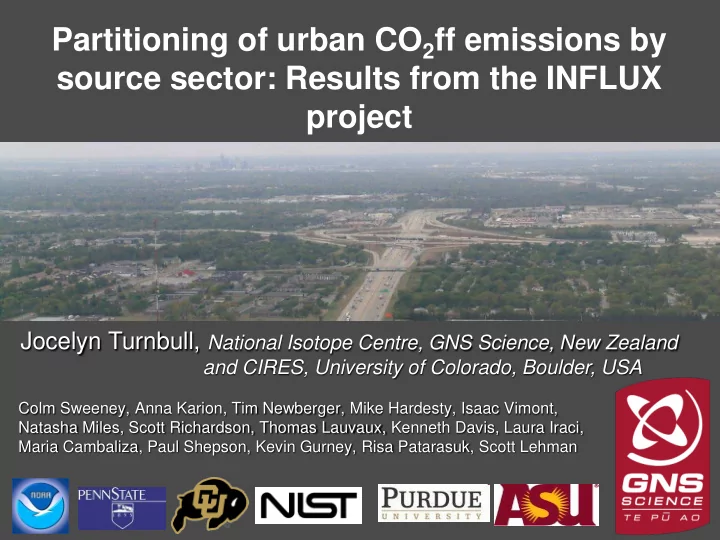

Partitioning of urban CO 2 ff emissions by source sector: Results from the INFLUX project Jocelyn Turnbull, National Isotope Centre, GNS Science, New Zealand and CIRES, University of Colorado, Boulder, USA Colm Sweeney, Anna Karion, Tim Newberger, Mike Hardesty, Isaac Vimont, Natasha Miles, Scott Richardson, Thomas Lauvaux, Kenneth Davis, Laura Iraci, Maria Cambaliza, Paul Shepson, Kevin Gurney, Risa Patarasuk, Scott Lehman
INFLUX: Indianapolis Flux Project Develop and test techniques/approaches for measurement of urban-scale greenhouse gas emission fluxes and to quantify uncertainties Aircraft-based measurements Bottom-up inventories Data analysis and Tower-based modeling measurements Driving tours FTS
Outline of this talk • Tower flask and in situ sampling strategy δ CO 2 as a wintertime proxy for δ CO 2 ff • Partitioning CO 2 ff source sectors using CO emission ratios (R CO ) – R CO for each source sector – Diurnal variability in observed and bottom-up total R CO
Tower Flask Sampling Strategy Wind direction for flask samples Instrumented towers, 75-150m high Continuous in situ CO 2 /CH 4 /CO Mid-afternoon conditional flask sampling ~50 species including CO 2 14 CO 2 CO CH 4 SF 6 hydrocarbons halocarbons
Trace gas enhancements relative to Tower One upwind background ∆ 14 CO 2 CO 2 CO δ CO 2 δ CO δ CO 2 ff δ δ δ Consistent enhancements in anthropogenic species at downwind towers
δ CO 2 as a wintertime proxy for δ CO 2 ff Summer All towers Tower Two 1:1 line if all δ CO 2 is due to δ CO 2 ff r 2 Winter Slope δ CO 2 / δ CO 2 ff correlations (ppm/ppm) All towers 1.2±0.1 0.8 Tower Two 1.0±0.2 0.8 LEF bkgd 1.7±0.2 0.6 In winter, δ CO 2 is entirely explained by δ CO 2 ff when Tower One background is used Continental background (LEF) gives quite different result
Seasonal variability in δ CO 2 / δ CO 2 ff 7 All downwind towers Tower Two Ratio of 1 if all δ CO 2 is due to δ CO 2 ff δ CO 2 approximates δ CO 2 ff during mid-afternoon for Nov – April
Partitioning CO 2 ff emissions by source sector using CO Hestia CO 2 ff NEI 2011 CO 3.3 TgC/yr 164,000 tonCO/yr 2.8x10 11 moles/yr 5.9x10 9 moles/yr Source sector emission ratios R CO
Validating bottom-up CO inventory with observed R CO Flask Flask δ CO vs δ CO 2 ff δ CO vs δ CO 2 Winter Slope RCO (ppb/ppm) In situ hourly average correlations Flask Flask In situ δ CO vs δ CO 2 CO:CO 2 ff CO:CO 2 CO:CO 2 Tower Two 9 ± 2 9 ± 1 7 ± 2 All towers 8 ± 2 7 ± 1 6 ± 2 Bottom-up 21 NEI 2011 Suggests that bottom-up NEI 2011 CO inventory is ~2.5x too large
Revised CO emissions and emission ratios NEI 2011 CO Hestia CO 2 ff Hestia CO 2 ff NEI 2011 CO 164,000 tonCO/yr 3.3 TgC/yr 3.3 TgC/yr 164,000 tonCO/yr 5.9x10 9 moles/yr 2.8x10 11 moles/yr 2.8x10 11 moles/yr 5.9x10 9 moles/yr Revised CO 62,000 tonCO/yr 2.2x10 9 moles/yr Offroad mobile revised by scaling to onroad mobile Onroad mobile revised according to Bishop and Stedman 2008 and McDonald et al 2013
Hestia bottom-up diurnal cycle in CO 2 ff emissions Local midnight Local midday Can we use R CO to detect the diurnal pattern in source sector CO 2 ff emissions?
Bottom-up midnight midday Local Local emission rates and observed mole fractions for CO and CO 2 Tower Two CO 2 Tower Three Tower Five Tower Nine CO Bottom-up (flat R CO ) Diurnally varying mobile R CO and CO bio Convolve Hestia CO 2 ff diurnal emission rate with source sector R CO to derive bottom-up diurnal CO emission rate
Bottom-up and in situ observed diurnal R CO Tower Two Tower Three Tower Five Local midnight Local midday Tower Nine Bottom-up (flat R CO ) Diurnally varying mobile R CO and CO bio
Conclusions When local upwind background constraint is used, δ CO 2 ff can be approximated by δ CO 2 in winter Correlate tracers are related to specific CO 2 ff source sectors In situ CO/CO 2 measurements for Indianapolis show that diurnal source sector partitioning for mobile emissions is approximately correct Next steps Improved source sector emission ratios Transport modelling of emission ratios Other correlate species
Recommend
More recommend